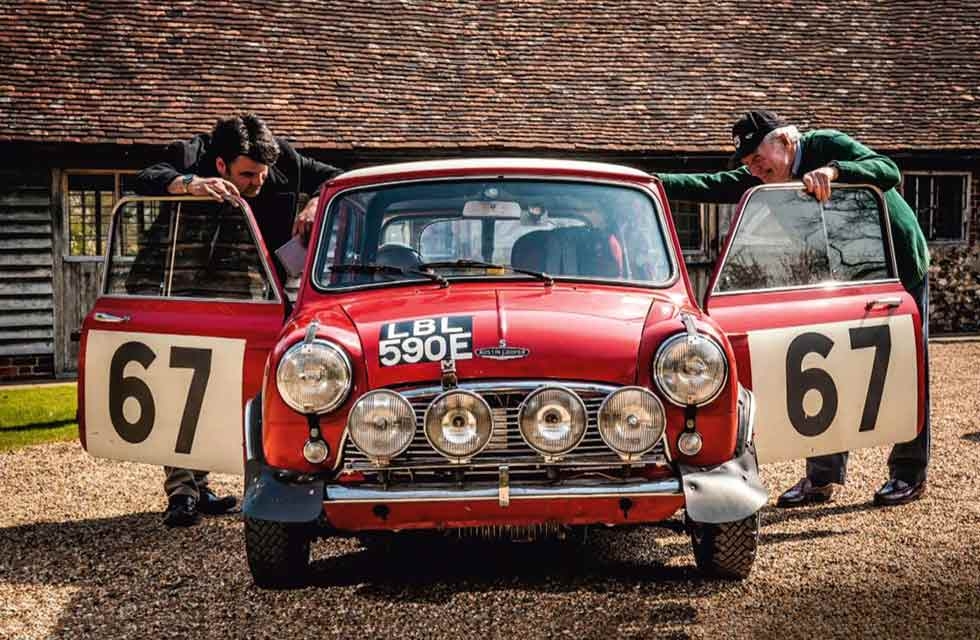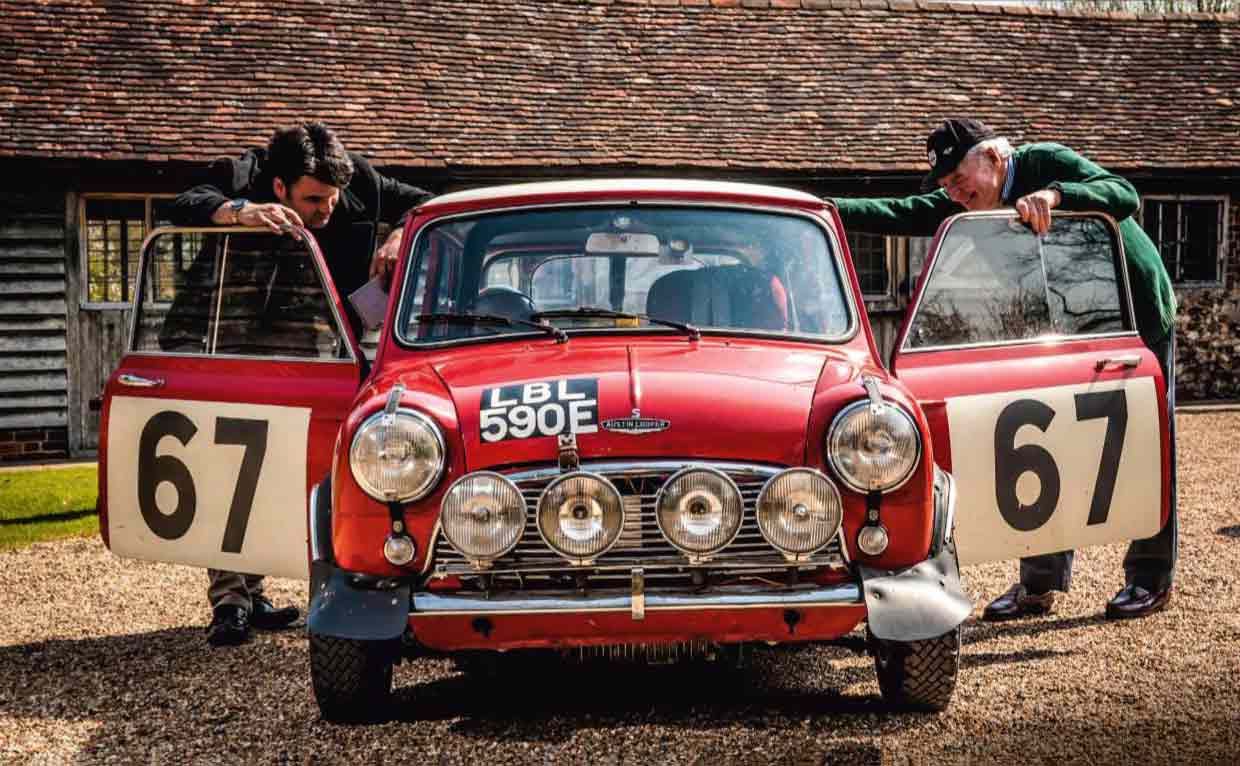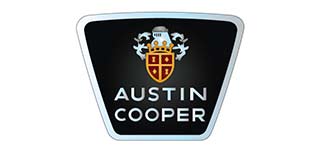
‘A small car makes small roads bigger’ We reunite Paddy Hopkirk with a rally Mini Cooper more important than his 1964 Monte winner. 1967 was Paddy Hopkirk’s most successful year rallying the Mini Cooper. We reunite him with one of his cars, and remember a landmark season together with former BMC deputy competitions manager Bill Price. Words Sam Dawson. Photography Laurens Parsons.
Paddy Hopkirk on why his 1967 Cooper was a rally giant
‘A SMALL CAR MAKES SMALLROADS BIGGER’ THE MOTOR SPORT HERO
An angry little red dot, fizzing and snorting with energy, darts between verdant banks in the wild depths of the Buckinghamshire countryside. As it draws nearer, its contours and features become unmistakable. Knobbly tyres barely contained by plastic wheelarch extensions. A row of spotlights filling its grille. Bonnet held down by a leather strap. The Tartan Red paint of a BMC works rally Mini Cooper, pockmarked by a lifetime of stonechips picked up in the midst of battle. These challengingly narrow lanes are its natural territory, but it’s not rallying today, it’s on a pilgrimage to meet its first driver. Paddy Hopkirk lives in the heart of this would-be special stage.

The Cooper yelps and growls as it slows, crackling down the gravel driveway. Hopkirk hears the unmistakable sound of the tuned A-series engine and accompanying gear whine, and emerges to welcome it like a homecoming son or daughter.
‘That year – 1967 – was my best,’ Hopkirk beams as owner John McIntosh draws the car to a halt in front of the house. ‘People always talk about 1964 and the Monte, but what made that rally memorable for people was the publicity it generated. What we achieved with the Mini in 1967 was very special.’ Hopkirk won more rallies that year than any other. ‘I got married in 1967 too,’ he adds. We’re joined by former deputy competitions manager Bill Price, who lives nearby. Hopkirk and Price make for a great double-act.
In 1967, with Hopkirk busy behind the wheel and management of the BMC Competitions Department about to be handed over from Ford-bound Stuart Turner to Peter Browning, Price remained the constant, part of the glue holding it all together. Today, while the diminutive, ebullient Hopkirk is a genial source of rapid-fire wit and fascinating anecdotes, the tall, more reserved Price is a mine of behind-the-scenes technical and political detail.
‘What made it so effective on rallies, aside from being so small and light, was having its engine over its driven wheels, improving traction,’ Hopkirk notes. ‘But the team was probably more important than the car. Stuart Turner was a very clever man. It was he who devised the idea of having suitable tyres available ahead of various stages of the Monte Carlo Rally, to make the most of that traction. He’d also employ old rally drivers to recce stages, then have their pace notes relayed back to the team by a motorcycle courier, so the drivers knew what to expect. Rallying is such a camaraderie sport – it’s not a single-minded thing, like running the 100 metres. With BMC in the Sixties the right mechanics, cars and co-drivers came together, and I was bloody lucky to be there.’

This Cooper was built on November 30 1966, delivered to the Abingdon-based Competitions Department on December 8, and registered LBL 590E – just one number ahead of Hopkirk’s 1967 Sebring 12 Hour class-winning MG BGT – on January 1 1967. After Rauno Aaltonen’s win on the season-opening Monte Carlo Rally avenged BMC’s acrimonious, hattrick-preventing disqualification of the previous year, LBL 590E was ready for its first event – the Rallye dei Fiori, centred on San Remo in Italy. Its driver was Paddy Hopkirk; the co-driver, Ron Crellin.
‘We’d practiced and practiced for that rally,’ Hopkirk recalls. ‘And the terrain was very rough in places – not ideal for the Mini – but we were leading, managing to stay ahead of Jean-François Piot’s Renault 8 Gordini. We were on the final stage, driving uphill, and had just passed a lorry – which we’d flashed our headlights and beeped the horn at, because it shouldn’t have been there, the road should’ve been closed to traffic – when a driveshaft broke and our drive was lost. So, given the lorry driver wasn’t supposed to be there, we persuaded him to give us a push over the brow of the hill.
‘It was downhill all the way to San Remo, and the finish line, from there, so we coasted the car, blipping the engine to give marshals the impression the car was still moving under its own power. As the road levelled out and we slowed down, we passed our service barge, a Wolseley 6/110 with mechanic Duggie Watts and competitions manager Peter Browning on board. They reconnected the driveshaft, but the repair wasn’t holding – we were using an early limited-slip differential and in those days it wasn’t very strong – so we got the service barge to push us through a tunnel, where the marshals couldn’t see us. They got us up to 80mph, so we could coast and blip all the way up to the final checkpoint, whereupon we stopped to have our timecard stamped – finishing second, Piot won – then we couldn’t get the car moving, opened the bonnet, and said “oh no, the driveshaft’s just gone!” It had been like that for the past 18 kilometers! It wasn’t a special stage, and I wasn’t a hero. I was bloody lucky given the circumstances – I was terrified.’
John opens the Mini’s bonnet, prompting Paddy and Bill to start looking over the car, pointing out the various modifications homologated for the season. Surprisingly, the most noticeable badge under the bonnet is not that of Austin or Morris – the black-finished competition-spec rocker cover doesn’t carry any decals – but the exotic tridente of Maserati. ‘Ah yes, Maserati air horns,’ notes Price. ‘The Italians made the best horns in the business, Maserati was FIAMM’s main competitor.
‘These cars came straight off the assembly line and went straight to Abingdon before registration for modification – we also had a good relationship with the licensing people, who’d get consecutive numberplates for us.’ Price starts to circle the car, pointing at the bare floor through the open door. ‘They’d be stripped down, extra welding made to strengthen the subframes, and sent for testing at Strata Florida in Wales.
‘A mechanic would be allocated a car, and a job sheet by a foreman, and would build the whole car, whereas with Ford at Boreham they had separate sections for engine, transmission, suspension and so on. It made for a better atmosphere in the workshop at BMC, because the mechanics would try and outdo each other to build a better car although we were all working together. It was like being in the Army!’
The 1967 season also marked the first appearance of another iconic Mini Cooper feature. ‘It was the year we homologated the Minilite wheels,’ says Price. ‘They had to be the same size as the car’s original road wheels – 4.5 inches – but they were made of magnesium, so they were light, and the pattern of the spokes afforded more cooling to the brakes. I’m not sure how much wind-tunnel testing would prove that, but it certainly showed. The Minilites were stronger than steel, and better in a puncture – steel wheels would end up deforming and folding around the brakes.’
Bill circles the car, getting a better view of the engine. ‘The major components were actually all standard. Conrods were lightened for balance purposes, and there was a different camshaft, lightened cam followers and flywheel, and we’d change the differential ratio depending on events – a 4.26 final drive was the most common, giving a 95mph maximum. We’d tell the drivers maximum revs were 8200rpm, not that they took any notice,’ he winks at Paddy.
‘You could fit any carburettors so long as they fitted on the manifold – which couldn’t be changed,’ he notes, gesturing to the Cooper’s twin SUs. ‘And you could only bore the cylinders out by 0.040in, hence the roadgoing Cooper’s engine sizes – 970 and 1275cc. The 970 could be bored out to 999cc, and the 1275 to 1293cc, fitting them neatly within the maximums for the 1000 and 1300cc classes. Despite it being for motor sport purposes, this is what determined the engine sizes for production cars – these engines were designed by Morris and went in several cars in the BMC range.’
Meanwhile, Paddy’s settling himself back into his old office – 590E’s firmly-bolstered driving seat. ‘I remember this,’ he says, pointing out the clamp he set up on top of the auxiliary instrument pod in front of the steering wheel. ‘This is where I’d put course notes for the night-time sections when Ron Crellin needed to get some sleep,’ he said. He notes the pair of rally-meters, ‘I didn’t need the tripmeter, that was more for Ron, but the Halda Speedpilot was for me – I could instantly check average speed. ‘These dashboards were bespoke to the rally cars, but they also influenced the design of the road cars,’ Hopkirk explains. ‘Things like clothes pegs and rubber bands around the sun-visors weren’t improvised, but anticipated us needing ways to store pace notes. We also put extended stalks on the switches so I could hit them and operate things like the windscreen washers without taking my hands off the wheel. Rallying heavily influenced interior design.’
Behind the wheel, Hopkirk recalls his second main exploit in 590E – recce runs for the 1967 Acropolis Rally. ‘It’s very rough, with rocky terrain, so much so that we considered using the Landcrab.’ In 1967, as an alternative to the Mini, the Competition Department had prepared an Austin 1800 for the Danube Rally. This Romanian event was similar to the Acropolis, and Tony Fall surprisingly-won.
‘But it wasn’t quick enough. So instead, we put in lots of practice in this Mini on the roads of Northern Greece. However, throughout this Ron and I were very worried about taking a wrong turn and ending up in Albania. It was behind the Iron Curtain at the time, and there were several little roads which would take you across the border by accident. There were tales of people going over there and not coming back.’ Once practice was over, 590E was lent to reporter Phil Turner, of The Motor, while Hopkirk and Crellin switched to a stablemate Cooper, LRX 830E.
‘The rough, hard roads were unsuitable for a Mini, and yet I won the 1967 Acropolis. I couldn’t claim I had some kind of special driving technique that secured the win, but what I will say is that rally driving is not like racing. On loose surfaces it’s more like a dance – you waltz the car through the corners. Driving on gravel is the same as powder skiing. You’re sliding all the time, using the power to keep the car pointed towards the apex of each corner. ‘The car held up very well – I’ve never been hard on cars anyway – but the mechanics were wonderful. Nowadays they have things like hydraulic ramps, plastic groundsheets and fully-equipped service parks. But on the Acropolis, they’d put a pair of spare tyres down to avoid damaging the bodywork, and roll the car onto its side – it was the best way to get to the sump-mounted gearbox.
‘Rally results weren’t like they are today, where everyone’s constantly kept informed of how well they’re doing via radio and a sense of competition builds up,’ Hopkirk notes. ‘Back then, you’d time yourself as you went along, and you’d only see how you were doing compared to other teams if you saw the stage results at an overnight halt. Throughout the Acropolis we heard rumours of the lightning performance of the Lotus Cortinas – and it’d be great news if one had gone off somewhere – so the win came as a nice surprise. In retrospect, I’m more proud of winning the 1967 Acropolis than the 1964 Monte.’ Hopkirk’s Mini was the last standing after Mäkinen’s gearbox failed and Rauno Aaltonen’s suffered a head-on collision with the VW Beetle of a spectating doctor who’d decided to check on a Renault crew whose car had fallen down a 150ft drop. Despite fluctuating oil pressure, Hopkirk held off Ove Andersson’s Lancia Fulvia HF and Bengt Söderström’s Lotus Cortina. ‘We were the last Acropolis winners to be presented with the trophy by the King of Greece – before he did a runner!’
Price also praises the mechanics. ‘In 1967 we were in a state of constant development, but we had to build a reliable car, especially with regard to the gearbox,’ he recalls. ‘We came up with something to stop idler gear bearing failure, for example, and worked closely with Castrol to create the right oil for the car – the problem with the Mini is that the engine and gearbox oil is shared. The Ford crews could just take a Cortina’s gearbox out on a rally and put a spare one in on the side of the road, but you couldn’t do that with a Mini because the whole engine had to come out. The engine itself was fundamentally reliable – the A-series was unsophisticated, just intended for punting small cars along the road.’
Before the season was over and the car was passed to driver David Friswell for 1968, Hopkirk was reunited with 590E one last time. ‘We went to Austria, where ADAC – the German Automobile Club – had organised a training session, with Rauno and I teaching rallying techniques at the Austrian Rally School near Vienna,’ Paddy recalls. ‘There was one guy there who had a Citroën, and he thought he knew it all – far more so than me and Rauno. He went out on the stage first time out and turned it over – boy we did laugh!’
Bill Price describes LBL 590E’s evolutionary development Homologation capacity caps defined the size of road-going Mini engines. Hopkirk reminisces about performing his signature Mini waltz Hopkirk puts 1967’s success down to a good car and a great team. Hopkirk recognises some of 590E’s rally addenda. Hopkirk drove LBL 590E to second on its first event. Hopkirk is prouder of his ’67 Acropolis win than the famous ’1964 Monte victory.
1967 Mini Cooper S
Engine 1293cc transverse four-cylinder, ohv, two SU HS2 carburettors
Max Power 91bhp @ 7200rpm;
Max Torque 83lb ft @ 4500rpm (never measured)
Transmission Four-speed manual, front-wheel drive
Steering Rack and pinion
Suspension Front and rear: wishbones, Moulton Hydrolastic spring/damper spheres Brakes
Discs front, drums rear
Weight 721kg
Performance
Top speed: 95mph;
0-60mph: 8.6sec
Fuel consumption 24mpg
Cost new n/a
Approximate value in 2019 £95,000 (UK)
Top 10 Mini motor sport achievements
10 Rauno Aaltonen wins the new Cooper 1275S’s very first rally, the 1964 Tulip.
9 At Mallory Park in 1969, Gordon Spice scores the Mini’s first outright BSCC race win.
8 Paddy Hopkirk wins the 1964 Monte Carlo Rally – sporting grit meets clever publicity.
7 Paddy Hopkirk wins the televised 1963 Tour de France Auto. French sales increase tenfold.
6 With the Cooper a raw prototype, Pat Moss wins its first outright rally, the 1962 Tulip.
5 Exploiting 1000cc class in 1961, John Whitmore wins Mini’s first BSCC title in a Don Moore 850.
4 In the Mini’s last competitive rally season, Paddy Hopkirk wins the 1967 Acropolis.
3 Richard Longman wins the 1979 BSCC, beating much more modern opposition in his 1275GT.
2 Warwick Banks wins the 1964 European Touring Car Championship in a 970S.
1 Rauno Aaltonen claims the 1965 European Rally Championship, with five outright wins.
Hopkirk en route to winning the 1964 Monte.
IAM RoadSmart
Following on from teaching rally driving skills in Austria in 1967, Paddy Hopkirk drew upon his motor sport experience to promote advanced and defensive driving techniques in order to improve road safety. This included an early- Seventies cartoon-based series in the Sunday Mirror, ‘Drive With Paddy Hopkirk,’ drawn by Porsche-racer and artist Nick Faure, illustrating these techniques in action. Hopkirk’s work continues with independent road safety charity IAM RoadSmart, which is dedicated to reducing the numbers of fatal and serious crashes on our roads by improving driving standards. Paddy is the charity’s mature driver ambassador, and is often seen talking about his role and the charity’s mission. For more info visit iamroadsmart.com






